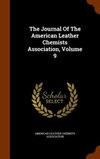l -抗坏血酸作为抗氧化剂在皮革涂饰中的应用
IF 0.5
4区 工程技术
Q4 CHEMISTRY, APPLIED
Journal of The American Leather Chemists Association
Pub Date : 2022-04-29
DOI:10.34314/jalca.v117i5.4909
引用次数: 0
摘要
以铬鞣牛皮为原料,在整理过程中将其染成白色。在整理后的整理层上分别添加1%、2%、3%、4%和5%的l -抗坏血酸。对照组不添加l -抗坏血酸,按标准方法加工。在这些过程之后,在柯尼卡美能达CM 3600d分光光度计上进行颜色测量分析。为了考察l -抗坏血酸对皮革其他性能的影响,按照TS 1008 EN ISO 105-B02 (2001 TS EN ISO 11640 2001)进行了耐光牢度试验,并按照标准方法进行了干摩擦牢度试验。根据NCSS (Number Cruncher Statistical System)方法对研究结果进行统计评价。研究结果显示,l -抗坏血酸使皮革呈珍珠粉色。结果表明,经l -抗坏血酸处理后,皮革的干摩擦牢度有所提高。在耐光性测试中,实验组皮革用蓝标记录的结果较好。本文章由计算机程序翻译,如有差异,请以英文原文为准。
Application of L-Ascorbic Acid as an Antioxidative Colorment in Leather Finishing
In this study, chrome tanned bovine crust leathers were dyed white during finishing process. Experiments with 1%, 2%, 3%, 4% and 5% L-ascorbic acid addition were performed on the finishing layer of the finishing application. L-ascorbic acid was not added to the control group and processed according to the standard method. After these processes, color measurement analyzes were performed on Konica Minolta CM 3600d spectrophotometer. In order to investigate the effects of L-ascorbic acid on other performance properties of leather, light fastness test according to TS 1008 EN ISO 105-B02 (2001 TS EN ISO 11640 2001) and dry rub fastness test according to standard method were performed. The results of the study were statistically evaluated according to the NCSS (Number Cruncher Statistical System) method. As a result of the research, it was observed that L-ascorbic acid gave a pearly pink color to the leathers. It was found that the dry rubbing fastness of the leathers treated with L-ascorbic acid improved. In the light fastness tests, the results of the experimental group leathers were recorded better by the blue scale.
求助全文
通过发布文献求助,成功后即可免费获取论文全文。
去求助
来源期刊

Journal of The American Leather Chemists Association
工程技术-材料科学:纺织
CiteScore
1.30
自引率
33.30%
发文量
29
审稿时长
3 months
期刊介绍:
The Journal of the American Leather Chemists Association publishes manuscripts on all aspects of leather science, engineering, technology, and economics, and will consider related subjects that address concerns of the industry. Examples: hide/skin quality or utilization, leather production methods/equipment, tanning materials/leather chemicals, new and improved leathers, collagen studies, leather by-products, impacts of changes in leather products industries, process efficiency, sustainability, regulatory, safety, environmental, tannery waste management and industry economics.
 求助内容:
求助内容: 应助结果提醒方式:
应助结果提醒方式:


